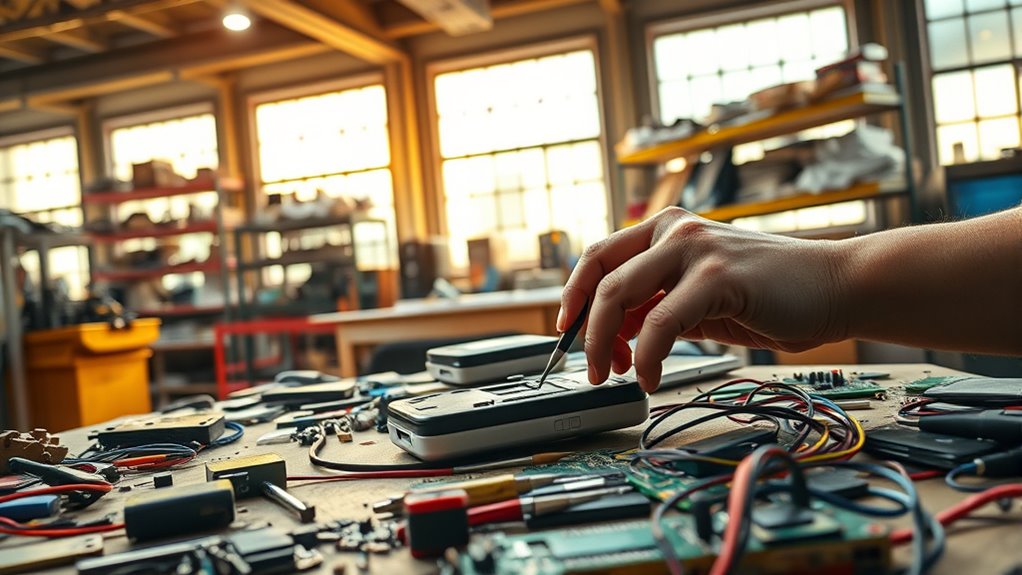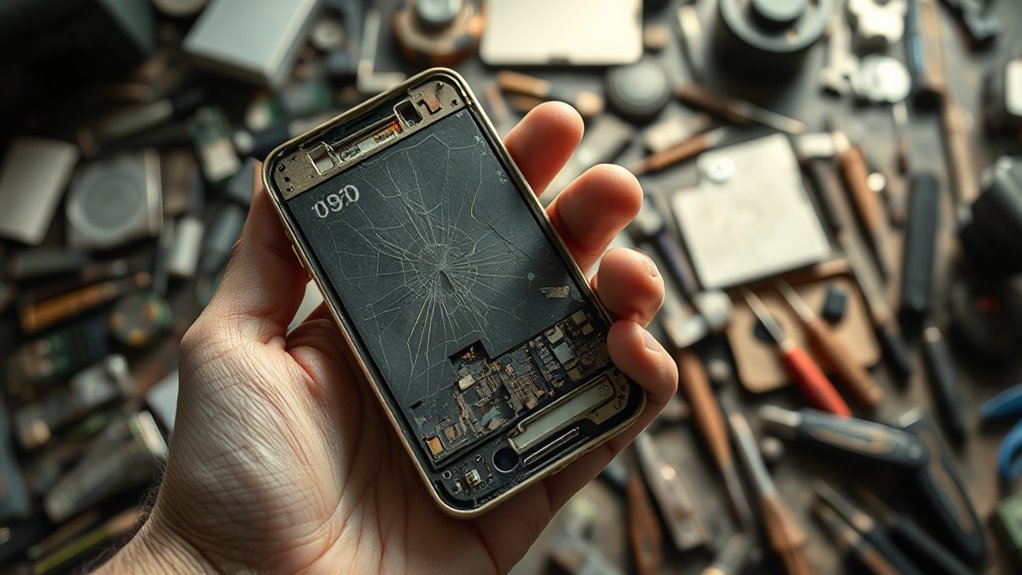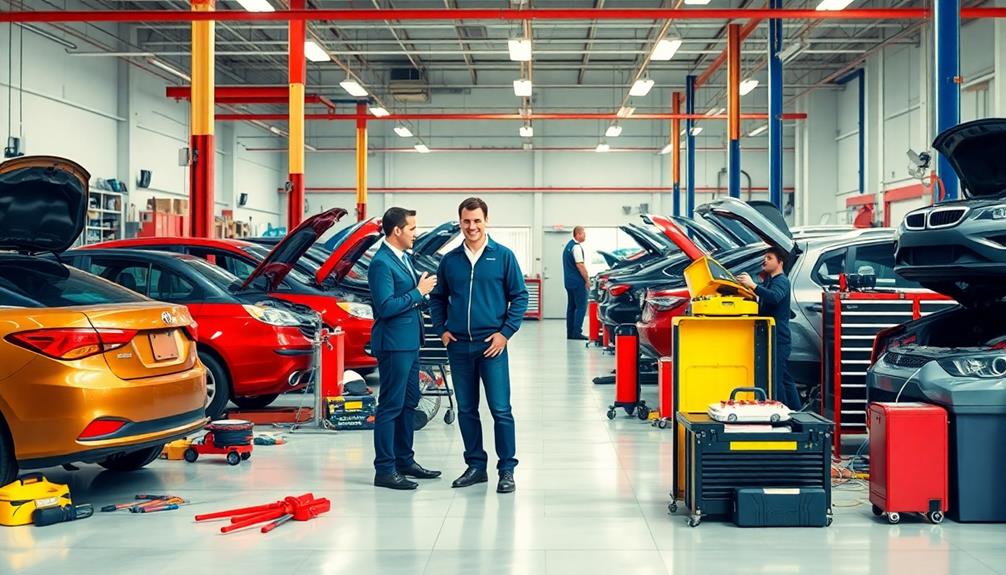The right to repair movement fights for your ability to fix your devices easily, affordably, and without restrictions from manufacturers. Companies often make repairs difficult or costly by limiting access to tools, parts, and repair information. Laws are changing to give consumers more control and promote competition, which can lower costs and reduce electronic waste. If you want to learn how these efforts protect your ownership rights and the environment, there’s more to explore.
Key Takeaways
- The Right to Repair movement advocates for consumers’ legal ability to repair their devices without restrictions.
- It challenges manufacturer-imposed barriers like limited access to repair manuals, parts, and specialized tools.
- Legislation in various regions aims to ensure repair fairness, reduce costs, and promote environmental sustainability.
- The movement seeks to dismantle monopolistic control, increasing competition among independent repair providers.
- Ultimately, it promotes consumer autonomy, device longevity, and reduces electronic waste.

Have you ever wondered why fixing your own devices can be so difficult? It’s a common frustration that many people face today. Manufacturers often make repairs complicated or even impossible without specialized tools or knowledge, pushing consumers toward their repair shops or authorized service centers. While repair shops can be helpful, they sometimes charge high fees or delay repairs, especially if your device is still under warranty. This is where the right to repair movement comes into play, advocating for consumers’ ability to fix their own devices or choose independent repair services without unnecessary restrictions.
Fixing your own devices is often complicated by manufacturers’ restrictions and the need for specialized tools.
One of the core issues fueling this movement involves warranty laws. Many manufacturers include clauses in their warranty agreements that prevent you from repairing or modifying your device yourself or using third-party repair services. These restrictions are often buried in fine print and can invalidate your warranty if you attempt to fix the device yourself. As a result, you might feel trapped, forced to rely solely on manufacturers’ authorized repair shops, which can be costly and limited in availability. The right to repair movement aims to challenge these restrictions, pushing for laws that protect consumers’ rights to repair their devices without voiding warranties or facing legal obstacles.
Legislation is gradually catching up to this movement. More states and countries are proposing laws that require manufacturers to provide access to repair manuals, spare parts, and tools. These laws seek to dismantle monopolistic control over repair options, giving consumers the freedom to choose how and where they fix their devices. For example, some laws stipulate that manufacturers cannot refuse to sell spare parts or repair tools to independent repair shops or individuals. This increased access helps foster competition, reduces repair costs, and extends the lifespan of electronics, benefiting both consumers and the environment. Additionally, proper storage and handling can significantly prolong the lifespan of electronic devices, making repairs less urgent and more cost-effective.
However, the fight isn’t solely about convenience or cost; it’s also about ownership and autonomy. When you buy a device, you should have the right to repair it when it breaks or becomes outdated. Restrictive warranty laws and the control of repair shops limit this freedom, often leading to wasteful disposal of otherwise functional devices. The right to repair movement emphasizes that consumers should have the legal and practical ability to repair their electronics safely and affordably, whether through repair shops or DIY methods.
Frequently Asked Questions
How Does the Right to Repair Impact Global Electronics Markets?
The right to repair impacts the global electronics markets by expanding market access and encouraging competition. When consumers and independent repair shops can fix devices easily, it boosts demand for spare parts and repair services, strengthening the global supply chain. You’ll find more options and potentially lower prices, as manufacturers face pressure to innovate and support repairability. This shift benefits consumers and promotes a more sustainable, resilient electronics industry worldwide.
What Are the Legal Barriers to Implementing Repair Rights?
Legal barriers to implementing repair rights act like fences around a garden, limiting your access. Warranty limitations often discourage repairs outside authorized services, making DIY fixes tricky. Intellectual property rights protect manufacturers’ innovations but can also block sharing repair information. These laws create invisible walls, preventing you from freely fixing devices, and often leave you relying solely on the original manufacturers—despite your right to repair.
How Do Repair Restrictions Affect Small Businesses and Independent Technicians?
Repair restrictions, like warranty restrictions and limited parts availability, considerably impact small businesses and independent technicians. You often face challenges getting genuine parts, which delays repairs and increases costs. Warranty restrictions may prevent you from fixing devices without voiding warranties, limiting your service options. These barriers reduce your ability to offer affordable, timely repairs, ultimately hurting your business and customer satisfaction.
What Role Do Consumer Advocacy Groups Play in the Movement?
Consumer advocacy groups play a crucial role in the movement by raising awareness and leading advocacy campaigns. They help you understand your rights to repair and push for policies that make repairs easier and more affordable. Through their efforts, they educate you on repair restrictions and lobby for legislation that supports consumer rights. Their work empowers you to demand better access to repair information and promote fair treatment in the repair industry.
Are There Environmental Benefits Directly Linked to the Right to Repair?
Imagine your old device thriving again, reducing e-waste and pollution. By supporting the right to repair, you directly promote sustainable manufacturing and resource conservation. This movement helps extend product lifespans, decreasing the need for new manufacturing, which cuts down on energy use and raw material extraction. Your actions contribute to a cleaner environment, turning discarded gadgets into valuable resources and making a real environmental difference.
Conclusion
Ultimately, embracing the right to repair empowers you to extend the life of your devices and reduce waste. It’s about taking control and making informed choices, rather than relying solely on manufacturers. As the saying goes, “A stitch in time saves nine.” By supporting this movement, you contribute to a more sustainable future, showing that when you repair rather than replace, everyone benefits. Your actions can make a meaningful difference—so choose to repair.









